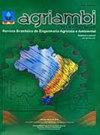Yield gap in cowpea plants as function of water déficits during reproductive stage
IF 1.4
4区 农林科学
Q3 AGRICULTURAL ENGINEERING
Revista Brasileira de Engenharia Agricola e Ambiental
Pub Date : 2020-01-01
DOI:10.1590/1807-1929/agriambi.v24n6p372-378
引用次数: 7
Abstract
ABSTRACT The cowpea bean presents low productivity in the Pará state, Brazil, due to low soil fertility and climatic adversity, mainly water deficiency. The aim of this study was to evaluate the yield gap of cowpea bean in northeast of Para state in response to water deficit during its reproductive phase. The experiment was carried out in Castanhal, PA, Brazil, during 2015 and 2016. A randomized block design with six repetitions and four treatments was used; where T1 consisted of 100% replacement of the crop evapotranspiration (ETc), T2 to 50%, T3 to 25% and T4 without irrigation, in the reproductive phase. The yield was determined at R9 stage. The simulations with the SARRAZON model were carried out with different sowing dates. The total deficiencies in the reproductive phase were spatialized considering the 30 locations in order to assess the temporal and spatial seasonality of water availability and the sowing period in the study region. The cowpea bean was sensitive to soil water availability with considerable reductions in productivity due to the increase in water deficit compared to the treatment T1 (100% ETc). When water deficits reached more than 47 mm, there were yield gaps over 20%. According to the spatial variability of simulated water deficiency, the sowing of cowpea bean in regions located above 2° latitude may extend until June 20 without showing high yield gaps.豇豆生殖期水分变化对产量差的影响
在巴西帕尔州,由于土壤肥力低和气候逆境(主要是缺水),豇豆产量低。本研究的目的是评价帕拉州东北部豇豆在生育期对水分亏缺的响应。该实验于2015年至2016年在巴西宾夕法尼亚州Castanhal进行。采用随机区组设计,6个重复,4个处理;其中T1为100%替代作物蒸散量(ETc), T2 ~ 50%, T3 ~ 25%, T4不灌溉。在R9期测定产量。采用SARRAZON模型对不同播期的土壤进行了模拟。为了评价研究区水分有效性和播种期的时空季节性,对30个地点的生殖期总亏缺进行了空间化处理。豇豆对土壤水分有效性敏感,与T1(100%等)处理相比,由于水分亏缺增加,豇豆的生产力显著降低。当水分亏缺大于47 mm时,产量缺口超过20%。根据模拟缺水的空间变异性,2°纬度以上地区豇豆播种期可能延续至6月20日,且无高产间隙。
本文章由计算机程序翻译,如有差异,请以英文原文为准。
求助全文
约1分钟内获得全文
求助全文
来源期刊

Revista Brasileira de Engenharia Agricola e Ambiental
Agricultural and Biological Sciences-Agronomy and Crop Science
CiteScore
2.70
自引率
16.70%
发文量
114
审稿时长
3-8 weeks
期刊介绍:
A Revista Brasileira de Engenharia Agrícola e Ambiental (Agriambi), periódico oficial da Asociación Latinoamericana y del Caribe de Ingeniería Agrícola (ALIA), é editada mensalmente, no formato eletrônico, pela Unidade Acadêmica de Engenharia Agrícola (UAEA) do Centro de Tecnologia e Recursos Naturais (CTRN) da Universidade Federal de Campina Grande (UFCG), destinando-se à divulgação de artigos científicos originais e inéditos, elaborados em Português, Inglês ou Espanhol. Com o auxílio de pareceres de Consultores, os artigos são aceitos ou não pela Equipe Editorial para publicação na Revista. A Agriambi aceita, também, a submissão de contribuições na modalidade de revisão de literatura.
 求助内容:
求助内容: 应助结果提醒方式:
应助结果提醒方式:


